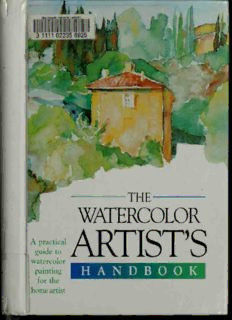Table Of ContentWATERCOLOR
ARTIST'S
A
practical
guide to
HANDBOOK
watercolor
painting
tor the
home
artist
1
BEL-TIB BOOKS
751.422 Artist's 2003
Artist's handbook.
Watercolor materials,
:
techniques, color and
composition, style,
qJo^
subject
ADTICT'C U Alii H D A A 1/ .
DATE DUE
u
APR 2 o ?n
M^'m
^l^lp'X
4
JAN
1 8 20 JS
HANDBOOK:
ARTIST'S
WATERCOLOR
materials • techniques • color and
composition • style • subject
Edited by SALLY HARPER
AN OCEANA BOOK
Firstedition forNorth America published in 2003 by
Barron's Educational Series, Inc.
Copyright © 2003 Quantum Publishing Ltd.
All rights reserved.
No partofthis bookmaybe reproduced in any form, by photostat,
microfilm, xerography, orany othermeans, orincorporated into
any information retrieval system, electronic ormechanical, without
thewrittenpermission ofthe copyrightowner.
Allinquiriesshouldbeaddressed to:
Barron's Educational Series, Inc.
250 Wireless Boulevard
Hauppauge, NewYork 788
11
http://www.barronseduc.com
International Standard BookNo. 0-7641-5619-5
Library ofCongress Catalog CardNo. 2002107842
Thisbook isproducedby
Oceana Books
6 Blundell Street
LondonN7 9BH
QUMWAH
Manufactured in Singaporeby Pica Digital Pte Ltd.
Printed in Hong Kongby Paramount Printing Co. Ltd.
98765432
1
INTRODUCTION
7
</)
The medium 9
The history ofwatercolor painting 10
MATERIALS
13
Paints and colors 14
a>
How to choose paper, boards,canvas,etc. 17
Brushes 20
Easels 21
Boards, palettes and other equipment 22
Lighting 23
TECHNIQUES
VJ 25
Laying washes 26
Foundations 32
Brush techniques 42
Color effects 50
Alternative techniques 66
Mixed media 75
M
U
1 80
COLOR AND COMPOSITION
83
Composition 84
Tonal values 100
The illusion ofdepth 107
Creating mood 112
Choosing colors 127
Mixing colors 132
STYLE 139
Painting an impression 140
Expressionist approaches 142
Abstracting from nature 144
Pure abstraction 148
SUBJECT
153
Still life 154
Plants and flowers 164
Landscape 170
Light and weather 180
Buildings 199
The animal world 206
Figures and portrarts 215
ClrK-arv 220
INDEX AND ACKNOWLEDGMENTS
222
uction
Of all the paint mec
perhaps the most idiosyncratic.With
watercolor. what is done is done.
Depending on the technique used, once
applied to paper, a watercolor wash will
stay there. But the very unpredictable
nature ofwatercolor painting also brings
special satisfaction to the artist.There is
intense pleasure involved in working with
watercolor and adapting to it. rather than
determining from the outset what the
result will be.
The art ofwatercolor painting has a
history that stretches back over 40.000
years.The first known examples were cave
paintings, using thick applications of opaque
water-based paint. Early Chinese artists.
however, used soft-haired brushes and
worked on silk and rice paper, whose
absorbent surfaces encouraged the use of
delicate, transparent washes.With just a
few fine strokes, these artists captured a
mood ofatmospheric space in their
landscapes, anticipating by several centuries
the work ofwestern watercolor artists
such asTurner and Girtm.
This is the strength ofwatercolor: its ability
to let the texture and tone of the paper
mingle wrth the vivacrty ofthe paint, en
that illusion oflight and depth for which
many a /e.True, watercolor n
have a mind ofits own. but that is .ill part of
the excrtement ofthis intriguing medium.
INTRODUCTION
"I don't do watercolor it's fartoo under running waterand washed away.
difficult" is a remark often heard from Watercolor has many virtues, its
amateur painters,even those who main attraction forartists being its
regard themselves as reasonably freshness and translucence, making it
proficient in other media, such as oils. It ideal for a variety ofsubjects, especially
cannot be denied that some people landscapes and flower paintings.As its
find watercolors a little harderto use name implies, pure watercolor is
than oils.This very attractive medium is mixed with waterand is transparent,
sometimes unpredictable, butthis very so that it must be applied from lightto
unpredictability should be regarded as dark, unlike oil paint oracrylics,which
a virtue, not a drawback.What people are opaque and can be built up from
really mean when they make this kind darkto light. Highlights consist ofareas
ofremark is that watercolors cannot ofthe paper left white orvery pale
be altered overand overagain as oils washes surrounded by darkerones.A
can; a color orwash, once laid down certain amount ofpre-planning is
on the paper must staythere.To some necessary at an early stage to work
extentthis is true, and it is out where the highlights are to be, but
understandable that people should feel some planning is always needed for
a certain nervousness when painting ordrawing,whatever medium
approaching a watercolor But, in fact, is being used.
many alterations can be made,and No one everquite knows how
often are,as a painting progresses:a watercolorwill behave,and many
wash in a colorthat has not come out watercolorartists find this very
quite right can be changed dramatically unpredictability one ofits greatest
by applying anotherwash on top ofit; assets.The purely practical advantages
areas can be sponged out orworked ofwatercolor painting arethatyou
over;and ifthe worst comes to the need little expensive equipment,the
worst the whole painting can be put painting can be done more or less
anywhere provided there is
enough light,and paints can
be cleaned up quickly, leaving
no mess.Sincethe paperis
relatively cheap,experiments
and mistakes are notvery
expensive.
LIBERTYWATERFALL
Shirley McKay

